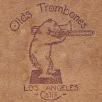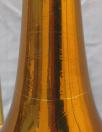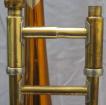
It's a bear!
Circa 1949 US-Marked Tenor Trombone with F-Attachment
Bore: .495”-.510” (12.6 mm-12.95 mm), .515" (13.1 mm) attachment
Bell: 8½” (216 mm)
At first examination, this dimensions and general layout clearly mark it as part of the R-20/A-20/V-20 lineage. From there, things are less clear. Its serial number (39,xxx) dates it from around 1949 - roughly contemporaneous with this catalog (which includes the R-20 Recording Symphony Bass and the A-15 Ambassador tenor, but not the A-20 Ambassador Bass). It does share many features with the A-20, but
- The bell is red brass (A-20 bells are yellow brass).
- The brace between the cork barrels has a circular cross-section; the A-20's I've seen have all had "flat oval" braces (similar to the bell brace on this horn) between the cork barrels.
- The A-20's I've seen have all had braces between each leg of their f-attachment; this horn has no braces down the center gap.
- The oldest A-20 I've been able to document has a much higher serial number (over 100,000).
U.
S.
MADE BY
F. E. OLDS & SON
LOS ANGELES
So it was obviously built under some sort of U. S. Government contract,
probably for military band use.MADE BY
F. E. OLDS & SON
LOS ANGELES
Unfortunately, it's been subjected to quite a few repairs, making it difficult to tell if any parts have been replaced. At the very least, the inner slide tubes do not match; the lower tube is duo-octagonal while the upper tube is not. By a stroke of good fortune, photos of what appears to be the same model horn (including the "U. S." marking) were recently posted to the Trombone Forum, giving me a basis for comparison. Based on that comparison, I'm reasonably certain that, with the exception of the inner slide tubes, the absence of a finger-ring under the mouthpiece receiver, and possibly some internal valve parts, this horn is completely original.
Now, on to the big question: "What is it?" Well, we know Foster Reynolds built horns for the U. S. mililtary while he was running his own company, so it stands to reason that he would go after that market again once he started working at Olds. My theory (and it's just a theory) is that there was some interest in the R-20, but it wasn't entirely suitable. Maybe it was too expensive, maybe it wasn't quite the sound they wanted, maybe they wanted a little different configuration in the f-attachment (I tend to think it was a cost issue). At any rate, this new design was developed and sold to the government. A few years later, when Olds needed a student-grade trombone with an f-attachment, they revisited this design, made a few changes, and the A-20 was born.
..
 Overall View Front |
 Engraving |
 Valve and Bell Brace |
 Overall View Back |
 Cork Barrels and Braces |
 End Bow |